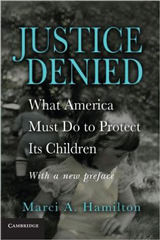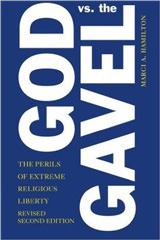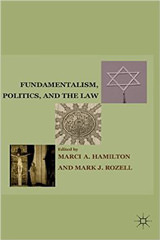The holidays are when many of us gather together and celebrate love and kindness to others. They are observed by the United States’ extraordinarily diverse population with varying degrees of religiosity, but, of course, religion plays a major role for many.
So right in the midst of the holidays is when I want to explain exactly how religious liberty in the United States is being transformed into a force to harm others. I am a Presbyterian and a believer in the Platonic ideal that knowledge precedes and should foster action, so I am praying that this explanation can move us beyond religious polarization and back to a more humane religious liberty and society.
The principle that needs to be understood is simple and profound: under the United States Constitution, religious liberty is the absolute right to believe anything, the right to speak publicly about your religion without government censorship, but when it breaks out into conduct, it does not license harm to others, as the Supreme Court averred in its very first free exercise case, Reynolds v. United States and then again in the 1990 decision, Employment Div. v. Smith.
Radical religious liberty law professors, who at the time seemed so milquetoast, like Douglas Laycock and Michael McConnell, and far-right political actors like the Becket Fund publicly overreacted to Smith, dramatically claiming that the end of religious liberty was near. That was not true. In fact, they had been trying to get the Court to give religious actors a mandatory right to violate any law since the 1970s, and Smith straightforwardly put an end to that crusade. The Court wisely kept its settled First Amendment doctrine in Smith, which was the bulwark against the religious drive to “liberty” with no limit. Everyone is bound by neutral and generally applicable laws, and the cases considering religious liberty claims did not merely look at the religious actor in a vacuum. The courts examined the religious claim in the context of the whole society and the interests in the common good. They asked what third-party interests would be harmed if the religious liberty claim were granted.
Three years later, in Church of Lukumi Babalu Aye v. Hialeah, the Court further clarified that under the First Amendment, if a law were not neutral or not generally applicable, it would be subjected to strict scrutiny. In other words, governments may not target or discriminate against, or persecute believers without a compelling interest of the highest order. This was the doctrine that kept religious tyranny at bay while protecting believers. In fact, the First Amendment by itself is more than adequate to provide exactly what we need. But that wasn’t good enough for the right-wingers who saw that they could not win the culture wars over abortion and same-sex marriage. Since they couldn’t persuade a majority of the American people that abortion is always wrong and same-sex marriages somehow destroy society, they turned to using religious liberty as a weapon against women and LGBTQ.
In a supreme irony, while the Smith detractors overreacted to the decision, claiming religious liberty was in peril, the little Native American Church at the heart of the Smith case was able to obtain the religious liberty it sought from state and federal legislators: permission to use the otherwise illegal drug, peyote, during their services. Religious liberty prevailed, but that was immaterial to those seeking power over the culture, not simply personal liberty to practice their faith.
With all their histrionics in 1990, this false-premise movement persuaded organizations that should have known better, like the ACLU, People for the American Way, and Americans United for Separation of Church and State to back their misleading narrative. Members of Congress honestly didn’t have a clue and could see no harm in giving believers a “little more” liberty and enacted a new statute—intended to reverse the effect of Smith—deceptively entitled the Religious Freedom Restoration Act, or RFRA.
This year is the 30-year anniversary of the first enactment of RFRA in 1993. In 1997, in Boerne v. Flores, the Supreme Court held that RFRA was unconstitutional because Congress did not have the power to create new constitutional rights. It could only enforce existing rights against the states, not fabricate new ones. According to the Court, RFRA was an attempt to concoct a new right to free exercise that went so far beyond the constitutional right to free exercise that it was unconstitutional. I represented the small city of Boerne, Texas; wrote the four Questions Presented, which covered the separation of powers, federalism, interpretation of Section 5 of the Fourteenth Amendment, and the Establishment Clause; wrote the briefs; and argued the case. While others have tried to narrow the holding to justify passing another RFRA, it is educational to read the case: the law was unconstitutional seven ways to Sunday, because Congress attempted to amend the First Amendment unilaterally.
Although it was clear that the original and the re-enacted RFRA would threaten civil rights like Title VII (as I testified), the religious lobbies once again prevailed and the Democrats blinked: RFRA was re-enacted in 2000, this time applying solely to federal law. Under the plain reasoning of Boerne, this new version, too, was unconstitutional, because it violated the separation of powers and Article 5 of the Fourteenth Amendment’s constitutional amendment procedures, but Presidents to date have irrationally feared religious lobbies and so the Department of Justice, in a great disservice to the United States, has not permitted the federal government to challenge RFRA’s constitutionality. So we are stuck with it until it is repealed.
Longtime First Amendment doctrine asked the question whether a religious liberty demand would harm others—until RFRA entered the picture. RFRA only requires the believer to prove a law imposes a “substantial burden” on their faith and then the burden shifts to the government, which must show that the law serves a “compelling interest” AND that it is the “least restrictive means” for this believer. There is no factor that requires the courts to consider the harm done to others by this demand to overcome the law. Take, for example, the Indiana mother who beat her young child with a hanger, who defended the abuse by saying she believed that “sparing the rod spoils the child.” She invoked RFRA to defend her violent actions and was sentenced to only probation.
Another excellent example of RFRA’s toxic nature was displayed in Burwell v. Hobby Lobby, where the owner of the for-profit hobby stores objected to certain forms of contraception that were required to be included in health coverage by the Affordable Care Act. He said they were abortifacients, but they weren’t. There was no consideration in that case of the direct harm to his female employees’ health benefit packages. Think about this: he could not select only co-religionists as employees under Title VII, because he was forbidden from discriminating against employees based on faith their faith, so many of the women weren’t the evangelical he was. Yet, RFRA let him tailor their benefits to his religious dogma. Under any other circumstances, his arbitrary exclusion of those benefits would have been religious and gender discrimination against his employees. RFRA let him off the hook.
More recently RFRA has been invoked by for-profit employers who don’t want LGBTQ employees in their spaces. Title VII doesn’t permit such discrimination, but RFRA provides a defense. This isn’t just about benefit packages but rather total exclusion from the workplace. It is cruel and a perfect example of religious liberty gone rogue—it’s not about whether these business owners can practice their religion. It’s whether they can force their religion on others. They are ridding their workspaces of qualified employees because they don’t approve of their sexual orientation. What’s next? Firing employees because they don’t attend church every week? RFRA says, “Go for it.” That is another step too far that is threatening the common good and democracy itself.
RFRA is the right’s darling at this point. Only right-wing organizations like the Becket Fund are celebrating its 30-year anniversary this year. In contrast, Democratic lawmakers have re-introduced the aptly named Do No Harm Act, which would carve back RFRA to protect children from abuse and child labor, equal employment, health care, federal contracts and grants, and government services.
As I have argued since I litigated RFRA in the nineties, for the sake of the United States and I am saying again now, to eliminate our current polarization it should be repealed, but the Do No Harm Act is an excellent place to start. Let the First Amendment govern religious liberty. Even repeal, though, won’t be enough to right what’s wrong with religious liberty now, because this idea that believers have no obligations to avoid harming others as they pursue their faith to the nth degree is the raison d’être of the Christian nationalist movement. Their tolerance for others’ suffering is extraordinary as shown by the anti-abortion movement that doesn’t even blink when a pregnant child, who by definition has been raped, can’t get an abortion or when a woman who carries a non-viable fetus can’t.
When the law can’t protect others from harm from religious actors, we enter a realm where the love and kindness of this season is displaced by brute power to impose one’s faith on others—regardless of the negative effects of the believers’ actions. That is a sure step toward religious tyranny and a theocracy. Right now, we in the United States are at the top of a very slippery slope. But it’s not too late to return to the First Amendment and a religious liberty doctrine that does not condone a religious takeover of the government, as House Speaker Mike Johnson obviously desires, as I explained here.
The Christian nationalist push—previously known as the movement to restore the United States to a so-called “Christian country”—doesn’t care about hurting anyone so long as their beliefs dominate. The harm they are willing to tolerate extends to replacing democracy with their top-down faith. That is truly a step too far.
Too many American citizens do not seem to understand what the right-wing religious powers have been concocting for decades and still have a dangerous tendency to presume if something is for religion it must be good for everyone. History shows us that is just malarkey. Time for Americans to push back against those who are self-righteously demanding a right to impose their faith on the rest of us, and to return to the days of a First Amendment that partakes in common sense, celebrates the common good, and nurtures love and kindness toward all.









